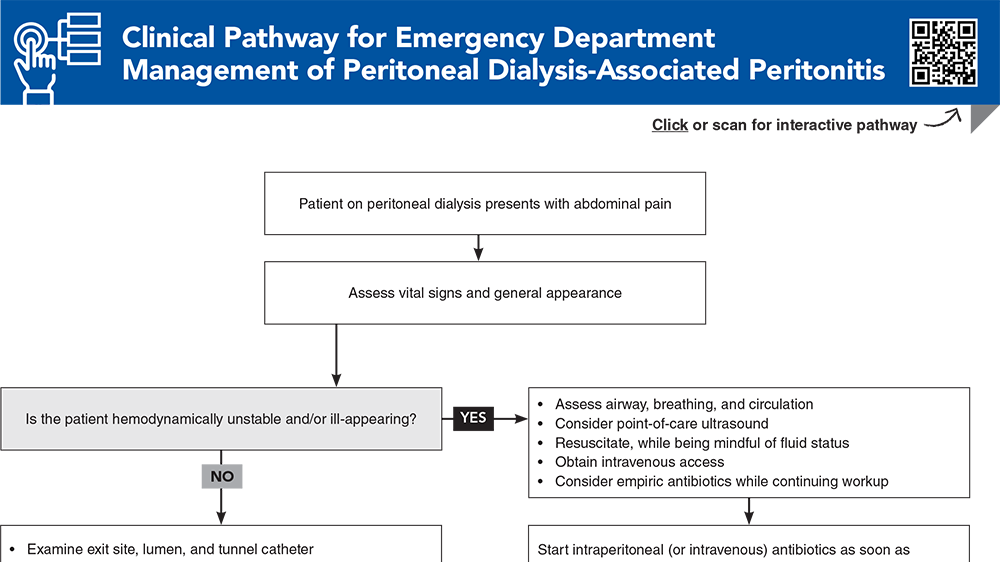Table of Contents
About This Issue
Patients with end-stage renal disease who receive hemodialysis or peritoneal dialysis seek disproportionately more ED care, and present with unique complications that require careful management. In this issue, you will learn:
What the general complications of end-stage renal disease are, and how to determine whether a patient is experiencing a complication of ESRD or their dialysis treatment
How to diagnose and manage a patient who is sent to the ED from a dialysis center for complications
What the particular complications of hemodialysis versus peritoneal dialysis are, and how each will present
The various presentations of vascular access complications: infection, stenosis, thrombosis, aneurysm, and steal syndrome
How to differentiate an arteriovenous aneurysm versus a pseudoaneurysm, and how to manage each
How to identify and manage life-threatening peritoneal dialysis-associated peritonitis
The special management considerations for dialysis complications in pregnant patients
- About This Issue
- Abstract
- Case Presentations
- Introduction
- Critical Appraisal of the Literature
- Etiology and Pathophysiology
- Systemic Complications of End-Stage Renal Disease
- Hemodialysis-Related Complications
- Vascular Access Complications
- Infection
- Stenosis and Thrombosis
- Aneurysm and Pseudoaneurysm
- Steal Syndrome
- Central Venous Stenosis
- Peritoneal Dialysis Complications
- Peritoneal Dialysis-Associated Peritonitis
- Other Peritoneal Dialysis Risk Factors
- Differential Diagnosis
- Prehospital Care
- Emergency Department Evaluation
- History
- Physical Examination
- Diagnostic Studies
- Laboratory Testing
- Laboratory Testing for Peritoneal Dialysis-Associated Peritonitis
- Imaging Studies
- Treatment
- Cardiac and Neurologic Complications
- Hypotension/Fluid Overload
- Dialysis Disequilibrium
- Vascular Access Infection
- Thrombosis
- Aneurysm/Pseudoaneurysm
- Steal Syndrome
- Central Venous Stenosis
- Peritoneal Dialysis-Associated Peritonitis
- Special Populations
- Pediatric Patients
- Pregnant and Lactating Patients
- Elderly Patients
- Controversies and Cutting Edge
- Contrast-Induced Nephropathy
- Disaster/Emergency Dialysis
- Opioid Use in Patients With End-Stage Renal Disease
- Disposition
- Summary
- Time- and Cost-Effective Strategies
- Risk Management Pitfalls for Emergency Department Patients With Dialysis Complications
- 5 Things That Will Change Your Practice
- Disclaimer
- Case Conclusions
- Clinical Pathway for Emergency Department Management of Peritoneal Dialysis-Associated Peritonitis
- Tables and Figures
- References
Abstract
In the United States, more than 450,000 patients are on dialysis due to end-stage renal disease. Compared to the general population, these patients account for a disproportionate number of emergency department visits due to higher rates of infection and cardiovascular complications, as well as issues unique to the process of dialysis itself, such as vascular access problems and dialysis disequilibrium syndrome. This issue describes the pathophysiology arising from hemodialysis and peritoneal dialysis-related complications, as well as the evaluation and initial treatment within the emergency department, based on best available evidence.
Case Presentations
- He was told by his primary care physician that he needed to have his arteriovenous fistula evaluated.
- He states the erosion has been present for the past few days. He does not think it is getting worse and he reports no pain.
- He is well-appearing, with normal vital signs. On examination, you note some erosion of the skin that appears to have an overlying scab and no surrounding erythema or bleeding, but you think that perhaps the fistula appears enlarged.
- You wonder why the patient was sent to the ED and whether the patient needs urgent evaluation of his fistula since the area does not appear infected and is not bleeding…
- She states that she recently started hemodialysis and has had 4 prior sessions that were without issue. During the session today, she acutely began to feel dizzy and somewhat confused, without any focal deficits.
- EMS reports that her glucose in the field was 150 mg/dL. Her vital signs are normal.
- She is well-appearing, alert, and oriented. She is answering questions and moving all extremities appropriately, but she continues to feel dizzy and “off.”
- You wonder whether she may have had a central stroke, given her nonspecific dizziness symptoms, or if something else may be going on…
- He states that after his latest session of dialysis, upon removing all of the dialysate fluid, he noticed the fluid was cloudy.
- He is well-appearing, and his vital signs are normal. On abdominal examination, he has active bowel sounds and diffuse abdominal tenderness to palpation with rebound. The peritoneal dialysis catheter site is clean, and there is no purulent discharge.
- You wonder what laboratory and imaging tests should be performed…
How would you manage these patients? Subscribe for evidence-based best practices and to discover the outcomes.
Clinical Pathway for Emergency Department Patients With Opioid Use Disorder
Subscribe to access the complete Clinical Pathway to guide your clinical decision making.
Key References
Following are the most informative references cited in this paper, as determined by the authors.
1. * Saha M, Allon M. Diagnosis, treatment, and prevention of hemodialysis emergencies. Clin J Am Soc Nephrol. 2017;12(2):357-369. (Review) DOI: 10.2215/CJN.05260516
8. * Long B, Koyfman A, Lee CM. Emergency medicine evaluation and management of the end stage renal disease patient. Am J Emerg Med. 2017;35(12):1946-1955. (Review) DOI: 10.1016/j.ajem.2017.09.002
16. * Padberg FT Jr, Calligaro KD, Sidawy AN. Complications of arteriovenous hemodialysis access: recognition and management. J Vasc Surg. 2008;48(5 Suppl):55S-80S. (Review) DOI: 10.1016/j.jvs.2008.08.067
38. * Salzer WL. Peritoneal dialysis-related peritonitis: challenges and solutions. Int J Nephrol Renovasc Dis. 2018;11:173-186. (Review) DOI: 10.2147/IJNRD.S123618
40. * Li PK, Chow KM, Cho Y, et al. ISPD peritonitis guideline recommendations: 2022 update on prevention and treatment. Perit Dial Int. 2022;42(2):110-153. (Clinical practice guidelines) DOI: 10.1177/08968608221080586
Subscribe to get the full list of 67 references and see how the authors distilled all of the evidence into a concise, clinically relevant, practical resource.
Keywords: ESRD, hemodialysis, peritoneal, dialysis, stenosis, aneurysm, steal, disequilibrium, peritonitis, fistula


